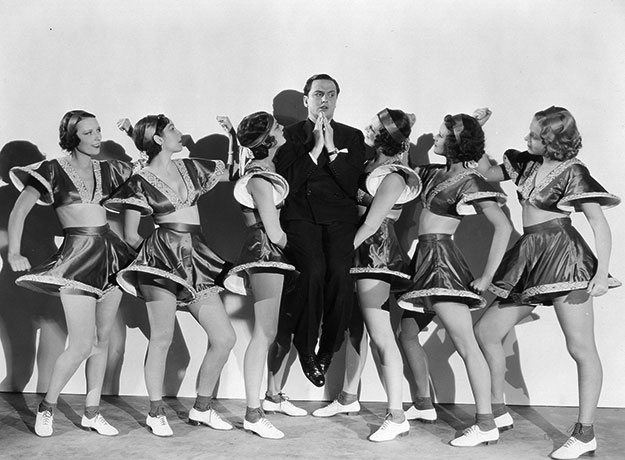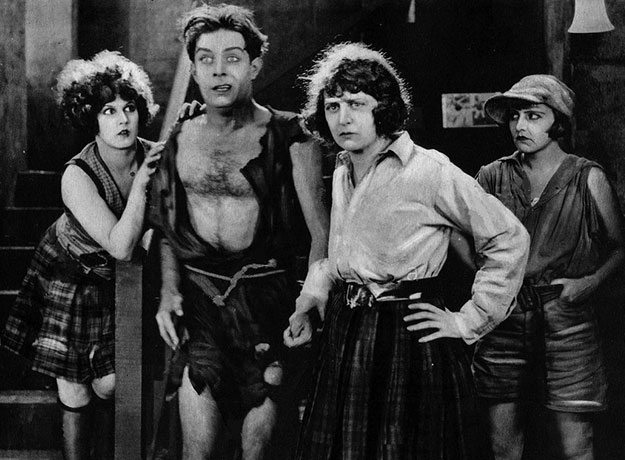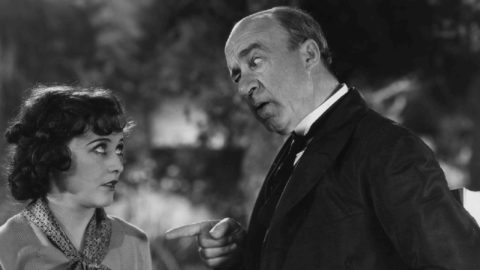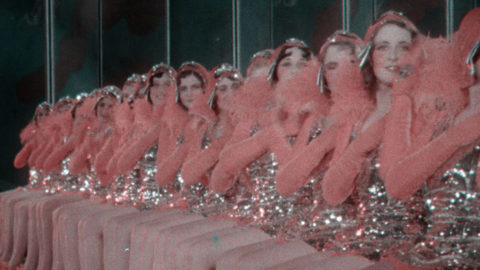The Last Man on Earth (1924) & It’s Great to Be Alive (1933)

It’s Great to Be Alive
Around the time of the 2016 election a few newspapers referenced the 1924 silent The Last Man on Earth as the first film to show a woman as president of the U.S. As any old-movie lover knows, “first” is a dangerous pronouncement. I have a whole set of words I use for these occasions, such as “early,” “pioneering,” “formative” and if I want a dose of extra class, “seminal.” So: The seminal American film image of a woman president is a crazy cat lady. Madame President shows up in The Last Man on Earth feeding a large group of strays on the terrace of a run-down White House. It’s rather sweet, and who knows, maybe a woman in the White House would be a cat person.
What’s depressing are the plot circumstances that got her into office. For a woman to be elected president, literally every single man on earth—save one tree-dwelling hermit who presumably wasn’t registered to vote—had to die first.
The Last Man on Earth and the even more interesting talkie version from 1933, It’s Great to Be Alive, both of which recently played at the Museum of Modern Art, quickly betray themselves as almost entirely male creations. If a woman were to create a cinematic world where a mysterious epidemic had killed all but one man on earth, you better believe the leftover would be Gary Cooper, Cary Grant, Gilbert Roland—the list goes on, but in any event, it sure wouldn’t be the 1924 film’s Earle Foxe or the talkie’s Raul Roulien, both unremarkable specimens with annoying personalities.
Admittedly, in the silent film, directed by J.G. Blystone, that’s sort of the point. Whether in the bucolic childhood prologue or later as an adult, lovesick Elmer Smith (Foxe) can’t get so much as a smile from the love of his life, Hattie (Derelys Perdue). Hattie tells him—wait for it—“I wouldn’t marry you if you were the last man on earth.” And so a brokenhearted Elmer takes up residence in the base of the tree, while a terrible disease called masculitis carries away all men over the age of 14. Eventually he’s rediscovered by a gang of lady gangsters, who kidnap him and sell him to the highest bidder, which turns out to be the U.S. government. Two “senatresses” from Massachusetts and California wind up having a boxing match (which needed a few rounds trimmed) for custody of Elmer.
That “last man on earth” line is echoed by Gloria Stuart in It’s Great to Be Alive, but Carlos Martin (Roulien) somewhat improbably has a different problem. He is catnip to the ladies, and even though he’s engaged to true love Dorothy (Stuart) they simply won’t leave him alone. He burns their photos and mash notes, he has a banquet to say farewell, but they’re undaunted. In one scene set in a garden, a luscious number named Toots (Joan Marsh) slides Carlos’s keys into one half of a very pre-Code décolletage and purrs, “Come and get it.” And he obligingly chases her around a tree, protesting all the way. When the fed-up Dorothy gives him the air, Carlos takes to the air, flying away to a desert island where masculitis passes him by. After about five years, an aviatrix discovers him on the island, and just in time, as the James-Whale-influenced attempt to make a “synthetic man” has literally blown up in everyone’s face.
It’s Great to Be Alive is a musical, directed by the not-terribly-musical Alfred L. Werker, and during the songs you can sense the movie wants you to think of Roulien as a star. But the problem is, on screen Roulien is the definition of forgettable, a status he would next reaffirm with a third-billed role in Flying Down to Rio that no one remembers because of Ginger Rogers and Fred Astaire. When Roulien is good, it’s due to whoever is in the scene with him, such as Herbert Mundin as his butler. They sing a song with lyrics of rather spectacular sexism, followed by a slapstick scene that makes wonderful use of forced perspective, as the two men drunkenly attempt to ascend a staircase. In another late-movie musical number, uncredited starlet Toby Wing steals the spotlight from Roulien without even trying.

The Last Man on Earth
The main interest of both films lies in seeing how an all-female society is set up. The Last Man flashes forward all the way to 1954, when the world has “senatresses,” great women scientists, and the aforementioned woman president. But the other women are basically the same types you’re used to: flapper, tomboy, set decoration. The movie never entertains the notion that not all women, absent the need or desire to please men, would still want to tease their hair, or apply false eyelashes, or wear skimpy rompers that crawl up the backside as a work uniform in an infectious-disease laboratory, much less as a lady-gangster outfit for a day of man-auctioning and light racketeering.
The attire in It’s Great to Be Alive tends to be more practical in the post-male world, at least for the women who are stepping in as cops raiding a speakeasy (apparently even an epidemic couldn’t repeal the Volstead Act) and as street-cleaners and the like. Dorothy Burgess plays a gangster named Al Moran without a hint of mugging. The speakeasy itself looks, no doubt deliberately, exactly like old photographs of lesbian bars.
There isn’t much of a visible U.S. government in It’s Great to Be Alive, save Edna May Oliver as a scientist who’s taken over by virtue of being—well, Edna May Oliver. It’s Oliver’s character who presides over the film’s climax: a world congress holds a dance-off for the hand of Carlos, in front of cheering throngs of identically dressed women who are seated in an impressive Art Deco conference hall.
First goes Cuba, with a Hollywood-style “sultry Latin” number. So far, so relatively routine. But then, here comes Czechoslovakia, and for whatever reason, what said “Czechoslovakia” to the folks at Fox in 1933 was weight-lifting and bicep-flexing and other displays of strength, executed more or less to the beat of the music. Finally, the Netherlands ladies come in and do a dance in wooden shoes, and it’s about as graceful as that sounds. The scene is nearly as much fun as the “world of music” number that closes out King of Jazz.
The oddest thing about both movies is the near-total lack of acknowledgement of any grief for the male population, save a brief moment in the earlier film when one character glances at a photo of her husband. Both films have a first half where you get to know a number of men, but in the second half, the men are all gone, and women have simply stepped in. The jokes mostly depend on female sexual frustration, but there isn’t much to indicate that men’s presence is otherwise missed. The world may not be as much fun without men, but life goes on in an orderly fashion, just the same.
Farran Smith Nehme writes about classic film on her blog, Self-Styled Siren, and recently published her first novel, Missing Reels. She is a member of the New York Film Critics Circle.







